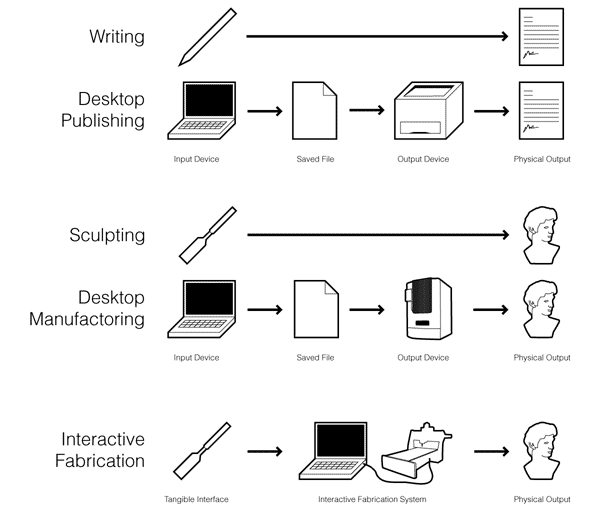Capstone Project Proposal – Interactive Fabrication
The Interactive Fabrication project will explore and develop new interfaces for digital fabrication from an art & design perspective. Our aim is to create prototype devices that use realtime sensor input to directly influence and affect fabricated output. The above figure illustrated how the current creative process for digital fabrication closely follows the desktop publishing metaphor: A computer is used to create a design, a file representing the design is saved, that design is then fed to an output device, and finally the output device manifests the design into physical form. This process is a far removed from traditional craft where the artist or designer interacts directly with the material using tools such as brushes or chisels to paint or sculpt.
Although there are numerous advantages to the current digital approach, we believe by more closely linking input to output artists and designers can better understand the nature of the material they are working with. Furthermore interactive fabrication opens up new creative possibilities for fabrication through interactive performance and improvisation.
Shaper
Shaper is a new prototype that will explore near real-time fabrication using an additive 3D printing process. We will construct a 3-axis fabrication device that can be controlled directly via computer. This will allow us to experiment with a range of sensor based interfaces for near real-time digital fabrication. The first iteration of this prototype will focus on a sketch interface where gestures are used to control the fabrication device. Different software modes allow the device to automate the creation of 3D form, a single sketch gesture can be repeated to slowly build up 3D form by shifting a print head slowly along the Z axis. Subsequent interface iterations will explore other forms of input such as real-time tracing of physical objects using a camera and the use of sound to control the amount of material dispensed from the print head.
Speaker
‘Speaker’ is an existing prototype that interactively sculpts wire forms based on the sounds of people talking. A micro-controller is used to analyze speech and control several small motors that push and bend wire. The sound level determines the shape the wire is physically bent into. The next stage will focus on rebuilding the system to allow more accurate shape forms to be created in. This will create a more interactive experience as people can more directly see how their voices affect the fabricated output.
Trace Modeler
‘Trace Modeler’ is an existing prototype that uses realtime video to create three-dimensional geometry. The silhouette of a foreground object is subtracted from the background and used as a two-dimensional slice. At user-defined intervals new slices are captured and displaced along the depth axis. The next stage will involve developing a system for outputting the forms directly to a fabrication device in an interactive manner, e.g. by sending the silhouettes incrementally to a laser cutter or milling machine.
Cheng Xu & Karl D.D. Willis

